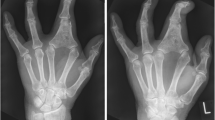Abstract
In the routine treatment at the hospital, it was observed that a 31-year-old Asian woman developed foot pain after work, with clinical manifestations including local tenderness, abrasion, and a rare case of polydactyly with bilateral foot asymmetry. In addition, we also found that the patient had two-handed symmetric polydactyly. According to our observations, there seem to be few similar cases reported in the past of a two-handed symmetric polydactyly combined with a feet asymmetry polydactyly in the same person, so this is a relatively rare reported case of polydactyly. This paper aims to present detailed case report and discuss related diseases in a morphological and clinical study.



Similar content being viewed by others
Data availability
Some or all data, models, or code generated or used during the study are available from the corresponding author by request.
Code availability
Not applicable.
References
Ahmed H, Akbari H, Emami A, Akbari MR (2017) Genetic overview of syndactyly and polydactyly. Plast Reconstr Surg Glob Open 5:e1549. https://doi.org/10.1097/GOX.0000000000001549
Blauth W (1978) Olason AT (1988) Classification of polydactyly of the hands and feet. Arch Orthop Trauma Surg 107:334–344. https://doi.org/10.1007/BF00381058
Castilla E, Paz J, Mutchinick O, Munoz E, Giorgiutti E, Gelman Z (1973) Polydactyly: a genetic study in south america. Am J Hum Genet 25:405–412
Jordan D, Hindocha S, Dhital M, Saleh M, Khan W (2012) The epidemiology, genetics and future management of syndactyly. Open Orthop J 6:14–27. https://doi.org/10.2174/1874325001206010014
Kapetanos GA (1984) Mixed polydactyly. An unusual case of a patient with seven-toed feet. Clin Orthop Relat Res 186:220–223
Malik S (2014) Polydactyly: phenotypes, genetics and classification. Clin Genet 85:203–212. https://doi.org/10.1111/cge.12276
Rafique A, Arshad A, Abu-Zaid A (2014) Rare presentation of foot postaxial polydactyly. J Foot Ankle Surg 53:331–334. https://doi.org/10.1053/j.jfas.2013.12.023
Seok HH, Park JU, Kwon ST (2013) New classification of polydactyly of the foot on the basis of syndactylism, axis deviation, and metatarsal extent of extra digit. Arch Plast Surg 40:232–237. https://doi.org/10.5999/aps.2013.40.3.232
Talamillo A, Bastida MF, Fernandez-Teran M, Ros MA (2005) The developing limb and the control of the number of digits. Clin Genet 67:143–153. https://doi.org/10.1111/j.1399-0004.2005.00404.x
Temtamy SA, Mckusick VA (1978) The genetics of hand malformations. Birth Defects Orig Artic Ser 14:1–619
Funding
(1) Project supported by Hainan Province Clinical Medical Center ([2021] No. 276); (2) Supported by Sanming Project of Medicine in Shenzhen. (No.SZZYSM202108013).
Author information
Authors and Affiliations
Contributions
SY and HY: Project development, Data Collection, Manuscript writing; CX and YH: Project development, Data Collection; SZ: Project development, Data Collection; MC: Project development; YL: Review and double check.
Corresponding author
Ethics declarations
Competing interests
The authors declare no competing interests.
Conflicts of interest
The authors have no conflicts to disclose.
Consent to participate
Not applicable.
Consent for publication
Not applicable.
Additional information
Publisher's Note
Springer Nature remains neutral with regard to jurisdictional claims in published maps and institutional affiliations.
Rights and permissions
Springer Nature or its licensor (e.g. a society or other partner) holds exclusive rights to this article under a publishing agreement with the author(s) or other rightsholder(s); author self-archiving of the accepted manuscript version of this article is solely governed by the terms of such publishing agreement and applicable law.
About this article
Cite this article
Yuan, S., Yang, H., Xu, C. et al. An unusual manifestation of asymmetric polydactyly of both feet and symmetrical polydactyly of both hands. Surg Radiol Anat 45, 25–28 (2023). https://doi.org/10.1007/s00276-022-03062-y
Received:
Accepted:
Published:
Issue Date:
DOI: https://doi.org/10.1007/s00276-022-03062-y




